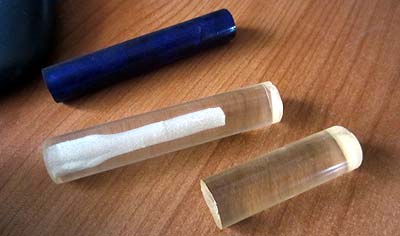MTB suspension forks that use elastomers for the spring (and "damping"!!!) are ancient and generally crap. Being ancient the elastomers will generally be hard, cracked and no longer springy. There are a few places that sell elastomer kits but for rarer forks or non-common applications, it is relatively easy to make your own.
The key to making your own elastomers is to get hold of some polyurethane rod in the necessary diameter and durometer (hardness). An Amazon search for "Polyurethane Rod" will pull up a number of results. If you've got a piece of old elastomer from your fork you can measure its diameter to get the right rod.
In my case, I needed to make elastomers for my daughter's Manitou 2 fork. She only weighs 27kg, so none of the commercially available elastomers would work.
For the Manitou 2 fork I ordered "Polyurethane Rod 40A Durometer, ASTM D-624, Amber, 3/4" OD, 6" Length". 40A durometer is about as soft as the polyurethane rod gets. Other common hardnesses include 60A, 80A, 90A and 95A.
In the picture below you can see three pieces of elastomer. The top blue elastomer is out of an old Rockshox Quadra 5 and was much too hard. The middle piece is an elastomer part way through the DIY process. To use these with the Manitou 2 fork you need to drill a hole through them as the rod that bolts the uppers to the lowers goes through the elastomer stack.

Drilling the hole is not particularly easy as the elastomer is difficult to hold and very bendy. About the only way to do this is to hold the elastomer in your hand a drill a pilot hole through the middle. The clear elasomer helps as you can see if the hole is continuing down the center. I also bored a short section of this elastomer with a larger diameter drill to make the initial stroke of the fork softer. This worked well. I also only put elastomers in one side of the fork to further soften it up.